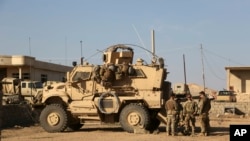The U.S.-led counter-Islamic State coalition says it is shifting its focus in Iraq away from supporting Iraqi combat operations, but is denying the United States is withdrawing forces from the country.
“Enabled by accelerated successes following the liberation of Mosul, the coalition will shift its focus in Iraq from enabling combat operations to sustaining military gains against Daesh,” the U.S.-led coalition announced Monday, using the Arabic acronym for the Islamic State terror group.
IS has lost approximately 98 percent of the territory it once held in Iraq and Syria. However, fighting remains in areas of the middle Euphrates River Valley, and U.S. military officials say critical training is still necessary.
“This is a reallocation of combat enablers. This is not a drawdown,” Lt. Col. Earl Brown, a spokesman for U.S. Central Command which overseas American military operations in the Middle East, told VOA on Monday.
Brown was responding to a report by the Associated Press saying that dozens of U.S. troops had started to withdraw from Iraq. The report included confirmation from an Iraqi government spokesman that a drawdown had begun.
Another CENTCOM spokesman, Col. John Thomas, told VOA that while a “small number” of troops have shifted from Iraq to Afghanistan, the numbers of American forces in Iraq remain about the same.
“There is a similar level of activity, but a different type of activity,” Thomas said.
Major U.S. activities will include training Iraqis on how to use new equipment and border screening training to prevent Islamic State fighters from returning to Iraq.
Some U.S. military personnel will shift to Kandahar, Afghanistan. Others will be replaced with trainers from NATO and the U.S. Still other service members will come home without replacements, but as far as a withdrawal, Thomas said, “we’re not there yet.”
The goal for U.S. forces in Iraq is "self-sustaining Iraqi Security Forces who can fight on their own,” counter-IS coalition spokesman Col. Ryan Dillon told VOA from Baghdad.
“As we get there, fewer coalition forces will be needed, but I'm not quite ready to talk about numbers and it's all conditions-based,” he added.
While the shift was announced Monday, several changes already have been made both inside and outside of Iraq and Syria.
For example, the U.S. Air Force Central Command launched a new training and advising team in Iraq last week. The small unit, known as the Coalition Aviation Advisory and Training Team, will work alongside Iraqi airmen to help with day-to-day aircraft operations, according to officials.
Also, A-10 Thunderbolt aircraft that were supporting the fights in Mosul and Raqqa from Turkey’ Incirlik Air Base were redeployed to the United States after the fall of Raqqa. Later, new A-10 assets from a base in South Carolina were deployed to Afghanistan.










